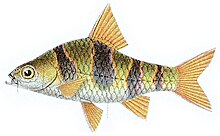Tiger barb
| Tiger barb | |
|---|---|
 |
|
|
Not evaluated (IUCN 3.1)
|
|
| Scientific classification | |
| Kingdom: | Animalia |
| Phylum: | Chordata |
| Class: | Actinopterygii |
| Order: | Cypriniformes |
| Family: | Cyprinidae |
| Genus: | Puntigrus |
| Species: | P. tetrazona |
| Binomial name | |
|
Puntigrus tetrazona (Bleeker, 1855) |
|
| Synonyms | |
|
|
The tiger barb or Sumatra barb (Puntigrus tetrazona),, is a species of tropical cyprinid fish. The natural geographic range reportedly extends throughout the Malay Peninsula, Sumatra and Borneo in Indonesia, with unsubstantiated sightings reported in Cambodia. Tiger barbs are also found in many other parts of Asia, and with little reliable collection data over long periods of time, definite conclusions about their natural geographic range versus established introductions are difficult. Tiger barbs may sometimes be confused with Systomus anchisporus, which are similar in appearance.
The tiger barb can grow to about 7-10 centimeters long (2.75 – 4 in) and 3-4 centimeters wide,(1.18 in), although they are often smaller when kept in captivity. Some can grow to around 13 centimeters as well. Native fish are silver to brownish yellow with four vertical black stripes and red fins and snout. The green tiger barb is the same size and has the same nature as the normal barb, but has a green body. The green tiger barb, often called the moss green tiger barb, can vary considerably in how green it looks; to some people it looks nearly black. Albino barbs are a light yellow with four barely visible stripes.
Tiger barbs have been reported to be found in clear or turbid shallow waters of moderately flowing streams. They live in Indonesia, Borneo, tropical climates and prefer water with a 6.0–8.0 pH, a water hardness of 5–19 dGH, and a temperature range of 77 - 82 °F or 25 - 27.8 °C. Their discovery in swamp lakes subject to great changes in water level suggests a wide tolerance to water quality fluctuations. Their average lifespan is six years.
The tiger barb is one of over 70 species of barb with commercial importance in the aquarium trade. Of the total ornamental fish species imported into the United States in 1992, only 20 species account for more than 60% of the total number of specimens reported, with tiger barbs falling at tenth on the list, with 2.6 million individuals imported. (Chapman et al. 1994). Barbs that have been selectively bred to emphasize bright color combinations have grown in popularity and production over the last 20 years. Examples of colour morphs (not hybrids) of tiger barb include highly melanistic green tiger barbs that reflect green over their black because of the Tyndall effect, gold tiger barbs and albino tiger barbs.
...
Wikipedia
